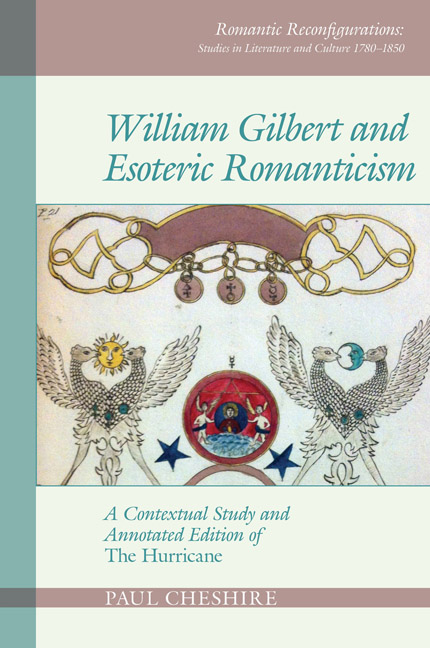 William Gilbert and Esoteric Romanticism
William Gilbert and Esoteric Romanticism 9 - Esoteric Romanticism
from Part Three - Conclusion
Summary
I know, that nothing is done towards enlightening the world at large, till the Esoteric overwhelms the Exoteric.
(HN §105)Gilbert's ‘lonesome pilgrimage’
Over the decade from 1788 to 1798 Gilbert passed through three very different groups: Methodists, occultists, and Romantics. In The Hurricane he called this a ‘lonesome pilgrimage’ (HN §108), but, however isolated he may have felt, he was clearly interacting with and being influenced by the groups he encountered. In 1788 he had a spiritual crisis caused by the Christian sense of sin that was a chief feature of the Methodism in which he was raised. Methodists regarded ‘conviction of sin’ as a necessary prerequisite for salvation, and expected it to be followed by true repentance and an assurance of forgiveness and redemption by Christ. As we have seen in chapter 1, Gilbert was not the only Methodist to require treatment in an asylum after getting stuck in this state of selfcondemnation. He referred back to this experience in The Conjuror's Magazine, writing ‘Conscience is a more severe revenger, than the most ingenious and inexorable tyrant on earth’ (CM, I: p. 389).
Gilbert recovered from his spiritual crisis by finding – with the help of John Henderson – a solution in the study of astrology and magic. It is plain from his Conjuror's Magazine articles that he regarded this radical change of direction as a further step on his pilgrimage. He declared that ‘the true magician is the true christian’ (CM, I: p. 77) and he distanced himself from the Methodists, having come to believe they had no true connection with the divine (CM, I: p. 337). He thus arrived at a broader ‘theosophical’ understanding of Christianity that was informed by Hermetic magic and astrology, as well as by the teachings of Swedenborg and the ancient Neoplatonic tradition.
On his return to Bristol in 1795 he met a circle of young poets, the Romantics, who – among other revolutionary ideas – were crediting nature as a means of spiritual renewal. However theologically problematic the pantheistic implications of this experience would later become (problems anticipated by Coleridge in ‘The Eolian Harp’), at that time they viewed exposure to nature as a means of bypassing the mystifications of priesthood to allow direct experience of the divine.
- Type
- Chapter
- Information
- William Gilbert and Esoteric RomanticismA Contextual Study and Annotated Edition of ‘The Hurricane’, pp. 219 - 228Publisher: Liverpool University PressPrint publication year: 2018
